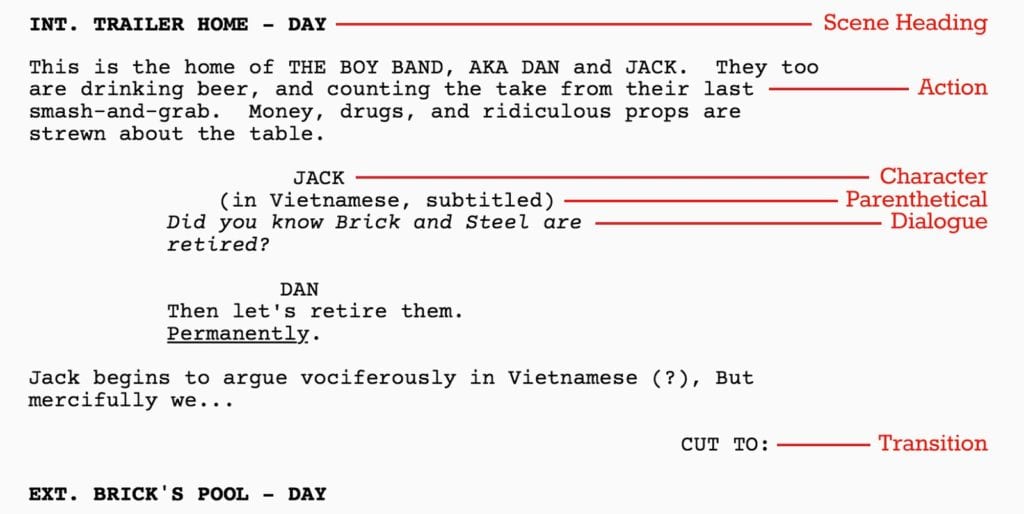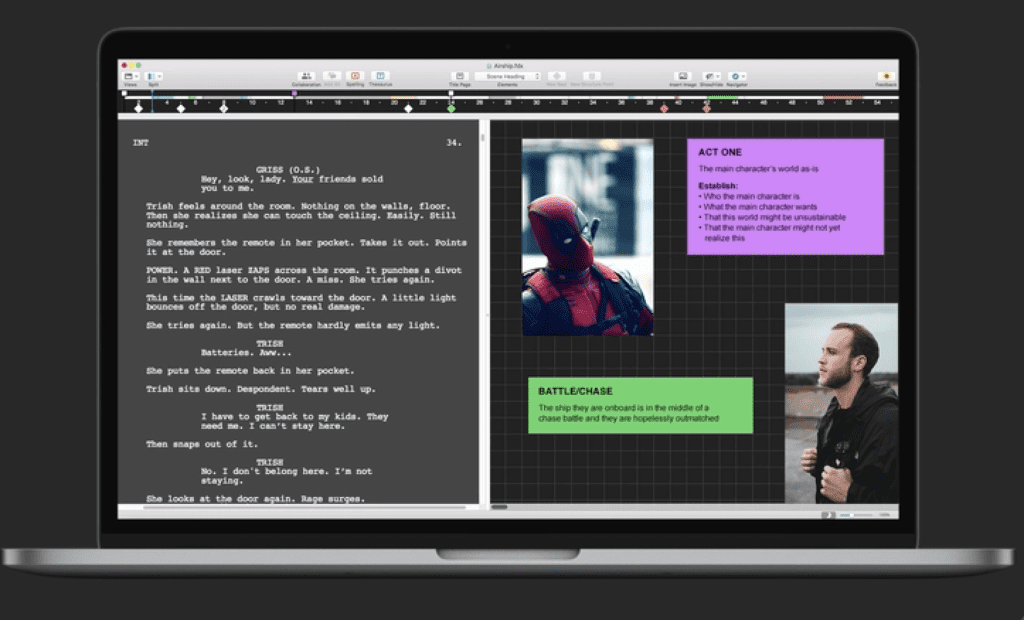9 Script Writing Tips for Your Short Film
You might have a great idea for a short film. However, turning that idea into a script can be a difficult process, especially for those with little to no experience with script writing. If you’d like to know how to write a script, these tips can be of much help to you.
What is Script Writing?
If you’re still asking yourself “what is script writing?”, this should clear that up. Script writing, also called screenwriting, is the process of writing stories through the medium of a screenplay.
Unfortunately, script writing isn’t as simple as pouring out all your thoughts for your film on a page. There is a specific format that you should follow.
Fortunately, this format of how to write a script is very simple to replicate once you learn it.
This brings me to my first piece of advice: know the elements of a script.
1. Know the Elements of a Script

Each scene in your script will start with a scene heading, or slugline, which will establish the setting of the scene. Scene headings are written in all caps, and start with “INT” or “EXT” to indicate if the scene is indoors (interior) or outdoors (exterior). This is followed by the name of the location and the time of day (“DAY” or “NIGHT”).
After your scene heading is the action paragraph, which describes what the viewer can see and hear in the scene.
Then, you can go into your dialogue. The character name will be on top in all caps, and will be followed by the lines the characters are saying. Parenthetical can be inserted in between the character name and the dialogue for more context. For example, if your character is saying a line sarcastically, the parenthetical can say “(sarcastically).” However, parentheticals shouldn’t be overused. The tone of dialogue can usually already be discerned based on the context of the scene.
Finally, if a scene uses any sort of transition besides a simple cut, it should end with a transition line in the script written in all caps. Examples of this include “FADE OUT,” “FADE TO BLACK,” “DISSOLVE TO,” and more.
2. Use the Right Script Writing Software
There are many different options for script writing software. Four of them include Final Draft, Fade In, Highland 2 and Celtx.
Final Draft is the industry standard script writing software. It automatically paginates and formats scripts to industry standards, and allows you to keep story maps and beat boards (for aspects such as characters arcs, plot points, and more). However, Final Draft will cost you $250. If you’re willing to shell out the money, it’s probably a worthy investment.
Fade In is seen by many as Final Draft’s direct rival. Fade In has almost all of the same features as Final Draft, except it has a different interface and doesn’t yet offer a split screen view (which allows you to look at two spots in the same script). At $80, Fade In is considerably cheaper than Final Draft.
Highland 2 and Celtx are more simple script writing software alternatives that come with free versions.
Highland 2 is an intuitive, easy-to-use service. As you type, it immediately formats your script for you. All you have to know is which words to capitalize and when to hit the return key. Highland 2’s more expansive paid version costs just $50.
Celtx has a simple interface which is great for beginner screenwriters. It’s cloud-based software, so it can be accessed wherever you go rather than being tied to just one device. Celtx’s paid version costs about $10 a month.
You can read more about the specific features of script writing software here.

3. Be Prepared and Organized
It’s probably not very efficient to go straight from your idea phase to your script writing phase. There are many things you should do in between that can make your script writing process much less arduous.
You can write drafts of your logline and your treatment in order to give your film’s story stable ground. A logline is a roughly one-sentence summary of your screenplay that includes your main conflict and how it relates to your main character, while a treatment is a much longer summary of your screenplay (which can be around 10 pages).
The logline and treatment drafts that you write before you complete your script probably will (and should) be different than the logline and treatment you end up with after completing your script. This is because the script writing process makes you realize how your story can actually pan out, and this often doesn’t perfectly align with your original intentions. Still, having logline and treatment drafts from which you can base your script can give you a better grasp of your story and get you in the script writing headspace.
4. Have the Right Script Length
With scripts, the golden rule is that one page of your script is about equivalent to one minute of screen time. Never write 30 pages and assume that you’ll be able to accomplish everything you wrote out in a time frame of 20 minutes. Likewise, don’t write 20 pages and assume that you’ll be able to stretch out the content to cover 30 minutes.
Since short films can range anywhere from one minute to thirty minutes, your short film script length can fall within a wide range. As a result, the deadlines you set for your daily writing progress are dependent on that. Still, regardless of your script’s length, milestones are crucial and keep you in check, which brings me to my next piece of advice: be disciplined.
5. Be Disciplined
As with anything difficult, writing a script will require discipline. You don’t wake up knowing how to write a script perfectly. It’s a gradual – and sometimes painful – process.
If your progress is not where you want it to be, you should carve out specific times each day in which you have to write a certain amount of material for your script.
Remember that when you’re writing a script, you don’t always have to start from the very beginning of the film. If there are any scenes at all in your head that you can visualize, write them down the moment you can. Sometimes, your script can be the end result of piecing together different scenes and then finding ways to fill in the parts in between them.
Also, your writing doesn’t have to be perfect the first time around. It’s easier to power through and churn out the first draft of your script and then go back and edit it repeatedly than to try to make the entire script perfect as you are first writing it.
6. Pace Your Story
Your story should have a reasonable, fluid pace.
This is especially important for short films, since you often have as little as 10 minutes to introduce and conclude your story.
Given your limited time frame, you shouldn’t introduce more in your story than you can effectively wrap up without the film feeling rushed. Your script should keep roughly the same pace from beginning to end. One exception to this is if your story speeds up rapidly at the end. However, this must be very intentional, as a story with an accelerating pace at the end can be done well, but it can also be done very poorly sloppily.
7. Be Fiscally Reasonable
As you write your script, you must remember that the events you’re writing out are (hopefully) bound to actually be shot in real life. Unlike with short stories, if you’re an independent filmmaker you can’t write simply anything in your short screenplay. You must keep in mind the budgetary restrictions that can limit what you’re able to film.
As a result, you’ll probably want to avoid inserting specific weather conditions, stunts, or magical elements into scenes.
8. Show, Don’t Tell

Dialogue is clearly a key element of what is script writing. However, you shouldn’t explain everything by having your characters explicitly state things out loud. Instead, try to see if the information can be better conveyed visually. Make use of your action paragraphs.
For example, if you want to convey that your protagonist is hesitant about accepting a particular job offer, try not to rely on having your protagonist just speak about the job offer to a friend. Have your protagonist show certain facial expressions and partake in actions that communicate the hesitance.
9. Have Strategies Ready to Overcome Writer’s Block
Whether you’re very experienced or barely know how to write a script, writer’s block affects everyone at some point. This could be the result of hitting a roadblock in your story and not knowing where to go with it, or it could be the result of simply struggling with motivation.
If you don’t know how to resolve a particular situation or section of dialogue in your script, that could be because you don’t have a full understanding of your characters. Once you have a full understanding of your characters, you are more likely to be able to imagine what they would do in a given situation, and then the story can develop from there. Basically, develop your characters more and then let your characters drive your story.
Even after you do this, you might still find yourself feeling like you have nowhere to go with your story. Regardless of the circumstances, though, you should not disrupt your daily writing routine. If your creative well has run dry, try writing a totally different script during your writing time. This could be a story that you’re already thinking of actually pursuing, or just one that you find from an online prompt generator like this one.
Writing something totally different keeps you in the script writing headspace and can eventually give you the inspiration you need to help you return to the script you were originally working on.
Conclusion
Script writing is difficult and time consuming. However, if you follow these tips and put in the necessary work, you’ll get a better idea of how to write a script and find that the effort was worth it.
If you’re interested in developing your idea or script into a film, remember to check out The Film Fund’s contest for the chance to receive up to $10,000.